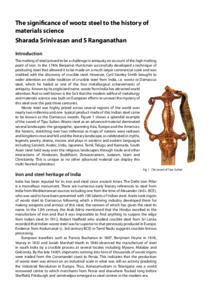Srinivasan, Sharada and Ranganathan, S
(2011)
The significance of wootz steel to the history of materials science.
In:
Pioneering Metallurgy: Origins of iron and steel making in the Southern Indian subcontinent: Telangana Field Survey, Interim Report 2011.
UKIERI, NIAS and Exeter University, pp. 1-3.
ISBN 9788187663539
![[img]](http://eprints.nias.res.in/916/1.hassmallThumbnailVersion/2011-Srinivasan%20S%20and%20S%20Ranganathan-Pioneering%20Metallurgy.pdf)  Preview |
|
Text
2011-Srinivasan S and S Ranganathan-Pioneering Metallurgy.pdf
- Published Version
Download (356kB)
| Preview
|
| Abstract: |
The melting of steel proved to be a challenge in antiquity on account of the high melting
point of iron. In the 1740s Benjamin Huntsman successfully developed a technique of
producing steel that allowed it to be made on a much larger commercial scale and was
credited with the discovery of crucible steel. However, Cyril Stanley Smith brought to
wider attention an older tradition of crucible steel from India, i.e. wootz or Damascus
steel, which he hailed as one of the four metallurgical achievements of
antiquity. Known by its anglicized name, wootz from India has attracted world
attention. Not so well known is the fact that the modern edifice of metallurgy
and materials science was built on European efforts to unravel the mystery of
this steel over the past three centuries. |
| Item Type: |
Book Chapter
|
| Subjects: |
School of Humanities > Archaeometallurgy
Programmes > Heritage Science and Society Programme |
| Divisions: |
Schools > Humanities |
| Date Deposited: |
11 Dec 2015 06:36 |
| Last Modified: |
11 Dec 2015 06:59 |
| Official URL: |
|
| Related URLs: |
|
| Funders: |
UNSPECIFIED |
| Projects: |
UNSPECIFIED |
| DOI: |
|
| URI: |
http://eprints.nias.res.in/id/eprint/916 |
Actions (login required)
 |
View Item |


